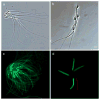Competition drives cooperation among closely related sperm of deer mice
- PMID: 20090679
- PMCID: PMC2824558
- DOI: 10.1038/nature08736
Competition drives cooperation among closely related sperm of deer mice
Abstract
Among the extraordinary adaptations driven by sperm competition is the cooperative behaviour of spermatozoa. By forming cooperative groups, sperm can increase their swimming velocity and thereby gain an advantage in intermale sperm competition. Accordingly, selection should favour cooperation of the most closely related sperm to maximize fitness. Here we show that sperm of deer mice (genus Peromyscus) form motile aggregations, then we use this system to test predictions of sperm cooperation. We find that sperm aggregate more often with conspecific than heterospecific sperm, suggesting that individual sperm can discriminate on the basis of genetic relatedness. Next, we provide evidence that the cooperative behaviour of closely related sperm is driven by sperm competition. In a monogamous species lacking sperm competition, Peromyscus polionotus, sperm indiscriminately group with unrelated conspecific sperm. In contrast, in the highly promiscuous deer mouse, Peromyscus maniculatus, sperm are significantly more likely to aggregate with those obtained from the same male than with sperm from an unrelated conspecific donor. Even when we test sperm from sibling males, we continue to see preferential aggregations of related sperm in P. maniculatus. These results suggest that sperm from promiscuous deer mice discriminate among relatives and thereby cooperate with the most closely related sperm, an adaptation likely to have been driven by sperm competition.
Figures


Similar articles
-
The dynamics of sperm cooperation in a competitive environment.Proc Biol Sci. 2014 Sep 7;281(1790):20140296. doi: 10.1098/rspb.2014.0296. Proc Biol Sci. 2014. PMID: 25056618 Free PMC article.
-
Disruption of ejaculates by male copulation in deer mice (Peromyscus maniculatus).Physiol Behav. 1987;41(1):53-8. doi: 10.1016/0031-9384(87)90130-2. Physiol Behav. 1987. PMID: 3685153
-
Sexual selection drives the coevolution of male and female reproductive traits in Peromyscus mice.J Evol Biol. 2023 Jan;36(1):67-81. doi: 10.1111/jeb.14126. Epub 2022 Dec 8. J Evol Biol. 2023. PMID: 36480400 Free PMC article.
-
Sperm competition.Curr Biol. 2004 Feb 3;14(3):R100-2. Curr Biol. 2004. PMID: 14986632 Review. No abstract available.
-
Selection on female remating interval is influenced by male sperm competition strategies and ejaculate characteristics.Philos Trans R Soc Lond B Biol Sci. 2013 Jan 21;368(1613):20120044. doi: 10.1098/rstb.2012.0044. Print 2013 Mar 5. Philos Trans R Soc Lond B Biol Sci. 2013. PMID: 23339235 Free PMC article. Review.
Cited by
-
Within-ejaculate sperm competition.Philos Trans R Soc Lond B Biol Sci. 2020 Dec 7;375(1813):20200066. doi: 10.1098/rstb.2020.0066. Epub 2020 Oct 19. Philos Trans R Soc Lond B Biol Sci. 2020. PMID: 33070737 Free PMC article. Review.
-
Characterization of a male reproductive transcriptome for Peromyscus eremicus (Cactus mouse).PeerJ. 2016 Oct 27;4:e2617. doi: 10.7717/peerj.2617. eCollection 2016. PeerJ. 2016. PMID: 27812417 Free PMC article.
-
Cellular geometry controls the efficiency of motile sperm aggregates.J R Soc Interface. 2018 Nov 14;15(148):20180702. doi: 10.1098/rsif.2018.0702. J R Soc Interface. 2018. PMID: 30429266 Free PMC article.
-
Secretory mouse quiescin sulfhydryl oxidase 1 aggregates defected human and mouse spermatozoa in vitro and in vivo.iScience. 2021 Sep 25;24(10):103167. doi: 10.1016/j.isci.2021.103167. eCollection 2021 Oct 22. iScience. 2021. PMID: 34667943 Free PMC article.
-
Positive selection in the adhesion domain of Mus sperm Adam genes through gene duplications and function-driven gene complex formations.BMC Evol Biol. 2013 Sep 30;13:217. doi: 10.1186/1471-2148-13-217. BMC Evol Biol. 2013. PMID: 24079728 Free PMC article.
References
-
- Moore HDM, Dvorakova K, Jenkins N, Breed WG. Exceptional sperm cooperation in the wood mouse. Nature. 2002;418:174–177. - PubMed
-
- Immler S. Sperm competition and sperm cooperation: the potential role of diploid and haploid expression. Reproduction. 2008;135:275–283. - PubMed
-
- Parker GA. Sperm competition and its evolutionary consequences in the insects. Biological Reviews. 1970;45:525–567.
-
- Parker GA. In: Sperm Competition and Sexual Selection. Birkhead TR, Moller AP, editors. Academic Press; Boston, MA: 1988. pp. 3–54.
Publication types
MeSH terms
Grants and funding
LinkOut - more resources
Full Text Sources
Other Literature Sources

